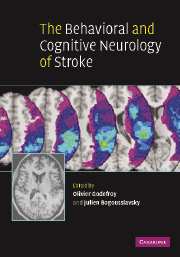Book contents
- Frontmatter
- Contents
- Contributors
- Preface
- 1 Evaluation of cognitive and behavioral disorders in the stroke unit
- Motor and gestural disorders
- Aphasia and arthric disorders
- Hemineglect, Anton–Babinski and right hemisphere syndromes
- 9 Hemispatial neglect
- 10 Anosognosia and denial after right hemisphere stroke
- 11 Asomatognosia
- 12 Disorders of visuoconstructive ability
- 13 Topographical disorientation
- Agnosia and Bálint's syndrome
- Executive and memory disorders
- Behavioral and mood disorders
- Dementia and anatomical left/right syndromes
- Index
- References
13 - Topographical disorientation
Published online by Cambridge University Press: 10 October 2009
- Frontmatter
- Contents
- Contributors
- Preface
- 1 Evaluation of cognitive and behavioral disorders in the stroke unit
- Motor and gestural disorders
- Aphasia and arthric disorders
- Hemineglect, Anton–Babinski and right hemisphere syndromes
- 9 Hemispatial neglect
- 10 Anosognosia and denial after right hemisphere stroke
- 11 Asomatognosia
- 12 Disorders of visuoconstructive ability
- 13 Topographical disorientation
- Agnosia and Bálint's syndrome
- Executive and memory disorders
- Behavioral and mood disorders
- Dementia and anatomical left/right syndromes
- Index
- References
Summary
General description of topographical disorientation
Topographical disorientation – the inability to find one's way in familiar or unfamiliar environments – remains poorly studied and is probably underestimated in stroke patients. However, recognition of this condition is usually easy and improves patient management.
This chapter deals with the selective loss of ability to find one's way in a familiar environment and to learn new paths. This disorder is generally known as “topographical disorientation,” but terms such as “topographical agnosia” and “topographical amnesia” have also been used to refer to similar conditions. Topographical disorientation is defined by a relatively selective loss of ability to find one's way in a familiar environment in the absence of global amnesia, severe disorders of visual perception or confusion. Following initial case reports (Foerster, 1890; Jackson, 1932; Meyer, 1900), numerous cases have been reported and their diversity suggests the existence of several varieties of topographical disorientation. Several influential reviews of the literature and classifications have been proposed (e.g. Levine et al., 1985; Farrell, 1996; Barrash, 1998; Aguirre and D'Esposito, 1999).
The presence of topographical disorientation is easily demonstrated in patients with difficulties finding their way in familiar places. The patient or caregiver may spontaneously report the difficulty, but clinical practice suggests that systematic interview significantly increases detection of the disorder. The disorder is especially striking in ambulatory patients.
- Type
- Chapter
- Information
- The Behavioral and Cognitive Neurology of Stroke , pp. 269 - 279Publisher: Cambridge University PressPrint publication year: 2007



